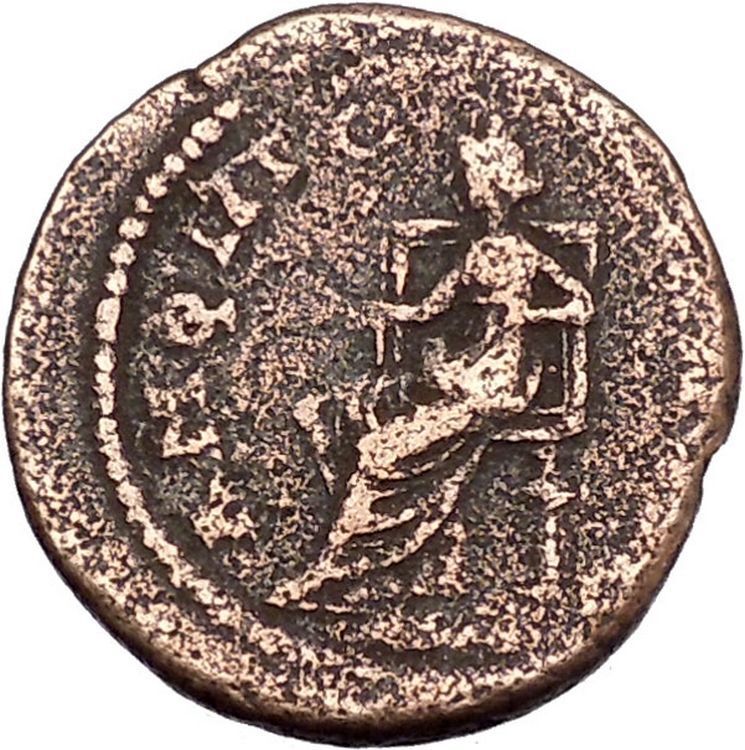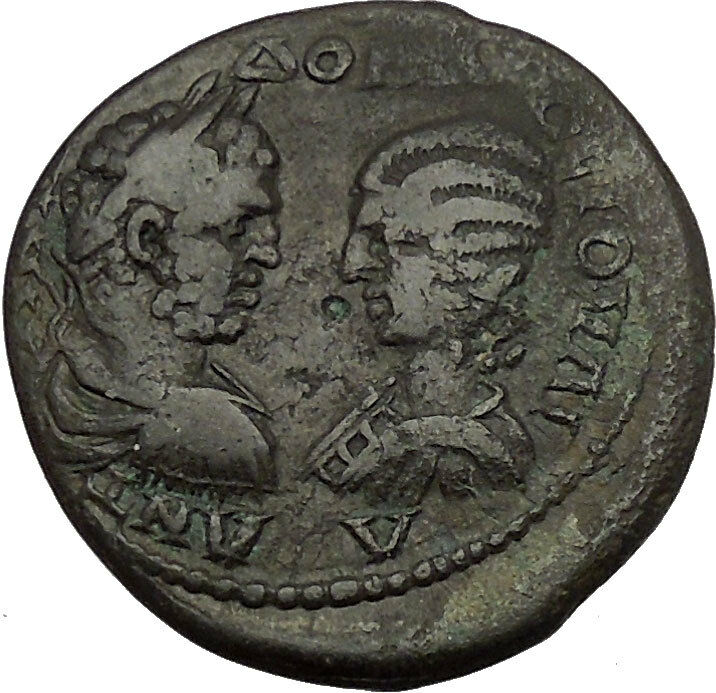|
Gallienus – Roman Emperor: 253-268 A.D.
Bronze 29mm (12.13 grams) of Antioch in Pisidia. Struck circa 253-268 A.D.
Reference: SNG France 1325 var.
IMP CA GALIHNVS PIVS, radiate and draped bust right.
ANTIOCHI COL, she-wolf standing right, suckling the twin foudners of Rome, Romulus and Remus; SR in exergue.
You are bidding on the exact item pictured, provided with a Certificate of Authenticity and Lifetime Guarantee of Authenticity.
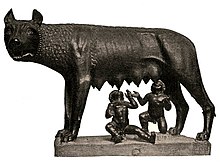 Romulus and Remus are Rome’s twin founders in its traditional foundation myth. They are descendants of the Trojan prince and refugee Aeneas, and are fathered by the god Mars or the demi-god Hercules on a royal Vestal Virgin, Rhea Silvia, whose uncle exposes them to die in the wild. They are found by a she-wolf who suckles and cares for them. The twins are eventually restored to their regal birthright, acquire many followers and decide to found a new city. Romulus and Remus are Rome’s twin founders in its traditional foundation myth. They are descendants of the Trojan prince and refugee Aeneas, and are fathered by the god Mars or the demi-god Hercules on a royal Vestal Virgin, Rhea Silvia, whose uncle exposes them to die in the wild. They are found by a she-wolf who suckles and cares for them. The twins are eventually restored to their regal birthright, acquire many followers and decide to found a new city.
Romulus wishes to build the new city on the Palatine Hill; Remus prefers the Aventine Hill. They agree to determine the site through augury. Romulus appears to receive the more favourable signs but each claims the results in his favour. In the disputes that follow, Remus is killed. Ovid has Romulus invent the festival of Lemuria to appease Remus’ resentful ghost. Romulus names the new city Rome, after himself, and goes on to create the Roman Legions and the Roman Senate. He adds citizens to his new city by abducting the women of the neighboring Sabine tribes, which results in the combination of Sabines and Romans as one Roman people. Rome rapidly expands to become a dominant force, due to divine favour and the inspired administrative, military and political leadership of Romulus. In later life Romulus becomes increasingly autocratic, disappears in mysterious circumstances and is deified as the god Quirinus, the divine persona of the Roman people.
The legend of Romulus and Remus encapsulates Rome’s ideas of itself, its origins, moral values and purpose: it has also been described as one of the most problematic of all foundation myths. Romulus’ name is thought to be a back-formation from the name Rome; Remus’ is a matter for ancient and modern speculation. The main sources for the legend approach it as history and offer an implausibly exact chronology: Roman historians dated the city’s foundation variously from 758 to 728 BC. Plutarch says Romulus was fifty-three at his death; which reckoning gives the twins’ birth year as c. 771 BC. Possible historical bases for the broad mythological narrative remain unclear and much disputed. Romulus and Remus are eminent among the feral children of ancient mythography.
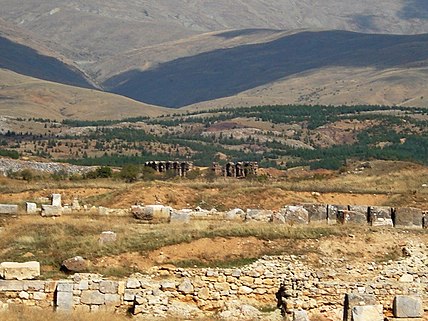 Antioch in Pisidia – alternatively Antiochia in Pisidia or Pisidian Antioch and in Roman Empire, Latin: Antiochia Caesareia or Antiochia Caesarea – is a city in the Turkish Lakes Region, which is at the crossroads of the Mediterranean, Aegean and Central Anatolian regions, and formerly on the border of Pisidia and Phrygia, hence also known as Antiochia in Phrygia. The site lies approximately 1 km northeast of Yalvaç, the modern town of Isparta Province. The city is on a hill with its highest point of 1236 m in the north. Antioch in Pisidia – alternatively Antiochia in Pisidia or Pisidian Antioch and in Roman Empire, Latin: Antiochia Caesareia or Antiochia Caesarea – is a city in the Turkish Lakes Region, which is at the crossroads of the Mediterranean, Aegean and Central Anatolian regions, and formerly on the border of Pisidia and Phrygia, hence also known as Antiochia in Phrygia. The site lies approximately 1 km northeast of Yalvaç, the modern town of Isparta Province. The city is on a hill with its highest point of 1236 m in the north.
Roman period
While the Hellenistic Kingdoms (the inheritors of Alexander the Great) were fighting each other and the Galatians, Rome became the most powerful state in Europe and started to follow a policy of expansion to the east. They invaded Macedon, Thrace, and the Dardanelles, and reaching Phrygia via Magnesia and Pisidia. They cowed the Galatians and according to the treaty signed in Apamea in 188 BC, they gave the land of Pisidia which they had got from Antiochos III, to their ally the Pergamon Kingdom which dominated the region. Attalos III, the last king of Pergamon, bequeathed his kingdom to Rome on his death in 133 BC Aristonikos who claimed Pergamon was defeated in 129, then Rome affected Anatolia with its well-developed, creative culture for centuries.
Although Anatolia was dominated by the Roman Empire as the province of Asia, Pisidia was given to the Kingdom of Cappadocia, which was an ally of Rome. During the following years, the authority gap which could not be filled by these kingdoms remote from central government, led to the rise of powerful pirate kingdoms, especially in Cilicia and Pisidia. The Romans were disturbed by these kingdoms and fought against them. Cilicia, Pamphylia, Phrygia and Pisida were freed from pirates and Roman rule was restored in 102 BC.
The geographical and strategical position of the region made it difficult to control the area and maintain constant peace. The Homonadesians, settled in the Taurus Mountains between Attaleia and Ikonion, caused problems for Rome. Marcus Antonius who had to control the roads connecting Pisidia to Pamphylia, charged his allied king Amyntas, King of Pisidia, to fight against Homonadesians, but Amyntas was killed during the struggle.
Then Rome started to colonize using military legions as a solution to the failure of the locally appointed governors. The Province of Galatia was established in 25 BC and Antioch became a part of it. To support the struggle against the Homonadesians logistically, the construction of a road called the Via Sebaste, the centre of which was Antioch, was started by the governor of the Province of Galatia, Cornutus Arrutius Aquila. The Via Sebaste was separated into two and directed to the southwest and southeast to surround the Homonadesians. Secondary connecting roads were built between these two roads. Rome by means of the Via Sebaste P.Sulpicius Quirinius brought an end to the Homonadesians problem in 3 BC, relocating survivors in different surrounding locations.
During the reign of Augustus, eight colonies were established in Pisidia, but only Antioch was honoured with the title of Caesarea and given the right of the Ius Italicum, maybe because of its strategic position. The city became an important Roman colony which rose to the position of a capital city with the name of “Colonia Caesarea“.
Hellenisation became Latinisation during the Roman period and it was applied in Antioch best. The city was divided into seven quarters called “vici” all of which were founded on seven hills like in Rome. The formal language was Latin until the end of the 3rd century. The fertility of the land and the peace brought by Augustus (Pax Romana: Roman Peace) made it easier for the veterans as colonists in the area to have good relations and integration with the natives.
One of the three surviving copies of the Res Gestae Divi Augusti, the famous inscription recording the noble deeds of the Emperor Augustus was found in front of the Augusteum in Antioch. The original was carved on bronze tablets and exhibited in front of the Mausoleum of Augustus in Rome, but unfortunately has not survived. The Antioch copy on stone was written in Latin which is a sign of the importance of the city as a military and cultural base of Rome in Asia. (One of the copies, in Greek and Latin, is in Ankara, the other, in Greek, in Apollonia -Uluborlu).
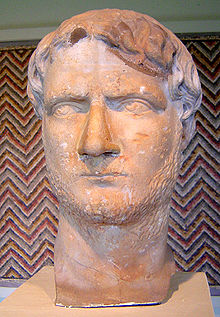 Gallienus – Roman Emperor: 253-268 A.D. Gallienus – Roman Emperor: 253-268 A.D.
( 253-260 A.D. with Valerian I | 260 A.D. with Valerian I and Saloninus | 260-268 A.D. sole reign )
Son of Valerian I and Mariniana | Husband of Salonina | Father of Valerian II and Saloninus
Gallienus (Latin: Publius Licinius Egnatius Gallienus Augustus; c. 218 – 268) was Roman Emperor with his father Valerian from 253 to 260 and alone from 260 to 268. He ruled during the Crisis of the Third Century that nearly caused the collapse of the empire. While he won a number of military victories, he was unable to prevent the secession of important provinces.
Rise to power
The exact birth date of Gallienus is unknown. The Greek chronicler John Malalas and the Epitome de Caesaribus report that he was about 50 years old at the time of his death, meaning he was born around 218. He was the son of emperor Valerian and Mariniana, who may have been of senatorial rank, possibly the daughter of Egnatius Victor Marinianus, and his brother was Valerianus Minor. Inscriptions on coins connect him with Falerii in Etruria, which may have been his birthplace; it has yielded many inscriptions relating to his mother’s family, the Egnatii. Gallienus married Cornelia Salonina about ten years before his accession to the throne. She was the mother of three princes: Valerian II, who died in 258; Saloninus, who was named co-emperor but was murdered in 260 by the army of general Postumus; and Marinianus, who was killed in 268, shortly after his father was assassinated.
When Valerian was proclaimed Emperor on 22 October 253, he asked the Senate to ratify the elevation of Gallienus to Caesar and Augustus. He was also designated Consul Ordinarius for 254. As Marcus Aurelius and his adopted brother Lucius Verus had done a century earlier, Gallienus and his father divided the Empire. Valerian left for the East to stem the Persian threat, and Gallienus remained in Italy to repel the Germanic tribes on the Rhine and Danube. Division of the empire had become necessary due to its sheer size and the numerous threats it faced, and it facilitated negotiations with enemies who demanded to communicate directly with the emperor.
Early reign and the revolt of Ingenuus
Gallienus spent most of his time in the provinces of the Rhine area (Germania Inferior, Germania Superior, Raetia, and Noricum), though he almost certainly visited the Danube area and Illyricum during 253 to 258. According to Eutropius and Aurelius Victor, he was particularly energetic and successful in preventing invaders from attacking the German provinces and Gaul, despite the weakness caused by Valerian’s march on Italy against Aemilianus in 253. According to numismatic evidence, he seems to have won many victories there, and a victory in Roman Dacia might also be dated to that period. Even the hostile Latin tradition attributes success to him at this time.
In 255 or 257, Gallienus was made Consul again, suggesting that he briefly visited Rome on those occasions, although no record survives. During his Danube sojourn (Drinkwater suggests in 255 or 256), he proclaimed his elder son Valerian II Caesar and thus official heir to himself and Valerian I; the boy probably joined Gallienus on campaign at that time, and when Gallienus moved west to the Rhine provinces in 257, he remained behind on the Danube as the personification of Imperial authority.
Sometime between 258 and 260 (the exact date is unclear), while Valerian was distracted with the ongoing invasion of Shapur in the East, and Gallienus was preoccupied with his problems in the West, Ingenuus, governor of at least one of the Pannonian provinces, took advantage and declared himself emperor. Valerian II had apparently died on the Danube, most likely in 258. Ingenuus may have been responsible for that calamity. Alternatively, the defeat and capture of Valerian at the battle of Edessa may have been the trigger for the subsequent revolts of Ingenuus, Regalianus, and Postumus. In any case, Gallienus reacted with great speed. He left his son Saloninus as Caesar at Cologne, under the supervision of Albanus (or Silvanus) and the military leadership of Postumus. He then hastily crossed the Balkans, taking with him the new cavalry corps (comitatus) under the command of Aureolus and defeated Ingenuus at Mursa or Sirmium.The victory must be attributed mainly to the cavalry and its brilliant commander. Ingenuus was killed by his own guards or committed suicide by drowning himself after the fall of his capital, Sirmium.
Invasion of the Alamanni
A major invasion by the Alemanni and other Germanic tribes occurred between 258 and 260 (it is hard to fix the precise date of these events),probably due to the vacuum left by the withdrawal of troops supporting Gallienus in the campaign against Ingenuus. Franks broke through the lower Rhine, invading Gaul, some reaching as far as southern Spain, sacking Tarraco (modern Tarragona).The Alamanni invaded, probably through Agri Decumates (an area between the upper Rhine and the upper Danube), likely followed by the Juthungi. After devastating Germania Superior and Raetia (parts of southern France and Switzerland), they entered Italy, the first invasion of the Italian peninsula, aside from its most remote northern regions, since Hannibal 500 years before. When invaders reached the outskirts of Rome, they were repelled by an improvised army assembled by the Senate, consisting of local troops (probably prǣtorian guards) and the strongest of the civilian population.On their retreat through northern Italy, they were intercepted and defeated in the battle of Mediolanum (near present day Milan) by Gallienus’ army, which had advanced from Gaul, or from the Balkans after dealing with the Franks.The battle of Mediolanum was decisive, and the Alamanni didn’t bother the empire for the next ten years. The Juthungi managed to cross the Alps with their valuables and captives from Italy. An historian in the 19th century suggested that the initiative of the Senate gave rise to jealousy and suspicion by Gallienus, thus contributing to his exclusion of senators from military commands.
The revolt of Regalianus
Around the same time, Regalianus, a military commander of Illyricum, was proclaimed Emperor. The reasons for this are unclear, and the Historia Augusta (almost the sole resource for these events) does not provide a credible story. It is possible the seizure can be attributed to the discontent of the civilian and military provincials, who felt the defense of the province was being neglected.
Regalianus held power for some six months and issued coins bearing his image. After some success against the Sarmatians, his revolt was put down by the invasion of Roxolani into Pannonia, and Regalianus himself was killed when the invaders took the city of Sirmium. There is a suggestion that Gallienus invited Roxolani to attack Regalianus, but other historians dismiss the accusation.It is also suggested that the invasion was finally checked by Gallienus near Verona and that he directed the restoration of the province, probably in person.
Capture of Valerian, revolt of Macrianus
In the East, Valerian was confronted with serious troubles. A band of Scythians set a naval raid against Pontus, in the northern part of modern Turkey. After ravaging the province, they moved south into Cappadocia. Valerian led troops to intercept them but failed, perhaps because of a plague that gravely weakened his army, as well as the contemporary invasion of northern Mesopotamia by Shapur I, ruler of the Sassanid Empire.
In 259 or 260, the Roman army was defeated in the Battle of Edessa, and Valerian was taken prisoner. Shapur’s army raided Cilicia and Cappadocia (in present day Turkey), sacking, as Shapur’s inscriptions claim, 36 cities. It took a rally by an officer Callistus (Balista), a fiscal official named Fulvius Macrianus, the remains of the Eastern Roman legions, and Odenathus and his Palmyrene horsemen to turn the tide against Shapur. The Persians were driven back, but Macrianus proclaimed his two sons Quietus and Macrianus (sometimes misspelled Macrinus) as emperors. Coins struck for them in major cities of the East indicate acknowledgement of the usurpation. The two Macriani left Quietus, Ballista, and, presumably, Odenathus to deal with the Persians while they invaded Europe with an army of 30,000 men, according to the Historia Augusta. At first they met no opposition. The Pannonian legions joined the invaders, being resentful of the absence of Gallienus. He sent his successful commander Aureolus against the rebels, however, and the decisive battle was fought in the spring or early summer of 261, most likely in Illyricum, although Zonaras locates it in Pannonia. In any case, the army of the usurpers surrendered, and their two leaders were killed.
In the aftermath of the battle, the rebellion of Postumus had already started, so Gallienus had no time to deal with the rest of the usurpers, namely Balista and Quietus. He came to an agreement with Odenathus, who had just returned from his victorious Persian expedition. Odenathus received the title of dux Romanorum and besieged the usurpers, who were based at Emesa. Eventually, the people of Emesa killed Quietus, and Odenathus arrested and executed Balista about November 261.
The revolt of Postumus
After the defeat at Edessa, Gallienus lost control over the provinces of Britain, Spain, parts of Germania, and a large part of Gaul when another general, Postumus, declared his own realm (usually known today as the Gallic Empire). The revolt partially coincided with that of Macrianus in the East. Gallienus had installed his son Saloninus and his guardian, Silvanus, in Cologne in 258. Postumus, a general in command of troops on the banks of the Rhine, defeated some raiders and took possession of their spoils. Instead of returning it to the original owners, he preferred to distribute it amongst his soldiers. When news of this reached Silvanus, he demanded the spoils be sent to him. Postumus made a show of submission, but his soldiers mutinied and proclaimed him Emperor. Under his command, they besieged Cologne, and after some weeks the defenders of the city opened the gates and handed Saloninus and Silvanus to Postumus, who had them killed. The dating of these events is not accurate, but they apparently occurred just before the end of 260. Postumus claimed the consulship for himself and one of his associates, Honoratianus, but according to D.S. Potter, he never tried to unseat Gallienus or invade Italy.
Upon receiving news of the murder of his son, Gallienus began gathering forces to face Postumus. The invasion of the Macriani forced him to dispatch Aureolus with a large force to oppose them, however, leaving him with insufficient troops to battle Postumus. After some initial defeats, the army of Aureolus, having defeated the Macriani, rejoined him, and Postumus was expelled. Aureolus was entrusted with the pursuit and deliberately allowed Postumus to escape and gather new forces. Gallienus returned in 263 or 265 and surrounded Postumus in an unnamed Gallic city. During the siege, Gallenus was severely wounded by an arrow and had to leave the field. The standstill persisted until the death of Gallienus, and the Gallic Empire remained independent until 274.
The revolt of Aemilianus
In 262, the mint in Alexandria started to again issue coins for Gallienus, demonstrating that Egypt had returned to his control after suppressing the revolt of the Macriani. In spring of 262, the city was wrenched by civil unrest as a result of a new revolt. The rebel this time was the prefect of Egypt, Lucius Mussius Aemilianus, who had already given support to the revolt of the Macriani. The correspondence of bishop Dionysius of Alexandria provides a colourful commentary on the sombre background of invasion, civil war, plague, and famine that characterized this age.
Knowing he could not afford to lose control of the vital Egyptian granaries, Gallienus sent his general Theodotus against Aemilianus, probably by a naval expedition. The decisive battle probably took place near Thebes, and the result was a clear defeat of Aemilianus. In the aftermath, Gallienus became Consul three more times in 262, 264, and 266.
Herulian invasions, revolt of Aureolus, conspiracy and death
In the years 267-269, Goths and other barbarians invaded the empire in great numbers. Sources are extremely confused on the dating of these invasions, the participants, and their targets. Modern historians are not even able to discern with certainty whether there were two or more of these invasions or a single prolonged one. It seems that, at first, a major naval expedition was led by the Heruli starting from north of the Black Sea and leading in the ravaging of many cities of Greece (among them, Athens and Sparta). Then another, even more numerous army of invaders started a second naval invasion of the empire. The Romans defeated the barbarians on sea first. Gallienus’ army then won a battle in Thrace, and the Emperor pursued the invaders. According to some historians, he was the leader of the army who won the great Battle of Naissus, while the majority believes that the victory must be attributed to his successor, Claudius II.
In 268, at some time before or soon after the battle of Naissus, the authority of Gallienus was challenged by Aureolus, commander of the cavalry stationed in Mediolanum (Milan), who was supposed to keep an eye on Postumus. Instead, he acted as deputy to Postumus until the very last days of his revolt, when he seems to have claimed the throne for himself. The decisive battle took place at what is now Pontirolo Nuovo near Milan; Aureolus was clearly defeated and driven back to Milan. Gallienus laid siege to the city but was murdered during the siege. There are differing accounts of the murder, but the sources agree that most of Gallienus’ officials wanted him dead. According to the Historia Augusta, an unreliable source compiled long after the events it describes, a conspiracy was led by the commander of the guard Aurelius Heraclianus and Marcianus.
Cecropius, commander of the Dalmatians, spread the word that the forces of Aureolus were leaving the city, and Gallienus left his tent without his bodyguard, only to be struck down by Cecropius.One version has Claudius selected as Emperor by the conspirators, another chosen by Gallienus on his death bed; the Historia Augusta was concerned to substantiate the descent of the Constantinian dynasty from Claudius, and this may explain its accounts, which do not involve Claudius in the murder. The other sources (Zosimus i.40 and Zonaras xii.25) report that the conspiracy was organized by Heraclianus, Claudius, and Aurelian.
According to Aurelius Victor and Zonaras, on hearing the news that Gallienus was dead, the Senate in Rome ordered the execution of his family (including his brother Valerianus and son Marinianus) and their supporters, just before receiving a message from Claudius to spare their lives and deify his predecessor.
Legacy
Gallienus was not treated favorably by ancient historians, partly due to the secession of Gaul and Palmyra and his inability to win them back. According to modern scholar Pat Southern, some historians now see him in a more positive light.Gallienus produced some useful reforms. He contributed to military history as the first to commission primarily cavalry units, the Comitatenses, that could be dispatched anywhere in the Empire in short order. This reform arguably created a precedent for the future emperors Diocletian and Constantine I.
The biographer Aurelius Victor reports that Gallienus forbade senators from becoming military commanders. This policy undermined senatorial power, as more reliable equestrian commanders rose to prominence. In Southern’s view, these reforms and the decline in senatorial influence not only helped Aurelian to salvage the Empire, but they also make Gallienus one of the emperors most responsible for the creation of the Dominate, along with Septimius Severus, Diocletian, and Constantine I.
By portraying himself with the attributes of the gods on his coinage, Gallienus began the final separation of the Emperor from his subjects.A late bust of Gallienus (see above) depicts him with a largely blank face, gazing heavenward, as seen on the famous stone head of Constantine I. One of the last rulers of Rome to be theoretically called “Princeps”, or First Citizen, Gallienus’ shrewd self-promotion assisted in paving the way for those who would be addressed with the words “Dominus et Deus” (Lord and God).
|





 Romulus and Remus are Rome’s twin founders in its traditional foundation myth. They are descendants of the Trojan prince and refugee Aeneas, and are fathered by the god Mars or the demi-god Hercules on a royal Vestal Virgin, Rhea Silvia, whose uncle exposes them to die in the wild. They are found by a she-wolf who suckles and cares for them. The twins are eventually restored to their regal birthright, acquire many followers and decide to found a new city.
Romulus and Remus are Rome’s twin founders in its traditional foundation myth. They are descendants of the Trojan prince and refugee Aeneas, and are fathered by the god Mars or the demi-god Hercules on a royal Vestal Virgin, Rhea Silvia, whose uncle exposes them to die in the wild. They are found by a she-wolf who suckles and cares for them. The twins are eventually restored to their regal birthright, acquire many followers and decide to found a new city. Antioch in Pisidia – alternatively Antiochia in Pisidia or Pisidian Antioch and in Roman Empire, Latin: Antiochia Caesareia or Antiochia Caesarea – is a city in the Turkish Lakes Region, which is at the crossroads of the Mediterranean, Aegean and Central Anatolian regions, and formerly on the border of Pisidia and Phrygia, hence also known as Antiochia in Phrygia. The site lies approximately 1 km northeast of Yalvaç, the modern town of Isparta Province. The city is on a hill with its highest point of 1236 m in the north.
Antioch in Pisidia – alternatively Antiochia in Pisidia or Pisidian Antioch and in Roman Empire, Latin: Antiochia Caesareia or Antiochia Caesarea – is a city in the Turkish Lakes Region, which is at the crossroads of the Mediterranean, Aegean and Central Anatolian regions, and formerly on the border of Pisidia and Phrygia, hence also known as Antiochia in Phrygia. The site lies approximately 1 km northeast of Yalvaç, the modern town of Isparta Province. The city is on a hill with its highest point of 1236 m in the north. Gallienus – Roman Emperor: 253-268 A.D.
Gallienus – Roman Emperor: 253-268 A.D.

